hankyoreh
Links to other country sites 다른 나라 사이트 링크
[Seoul travels] Returning home to the streets of Seoul and empathizing with Odysseus
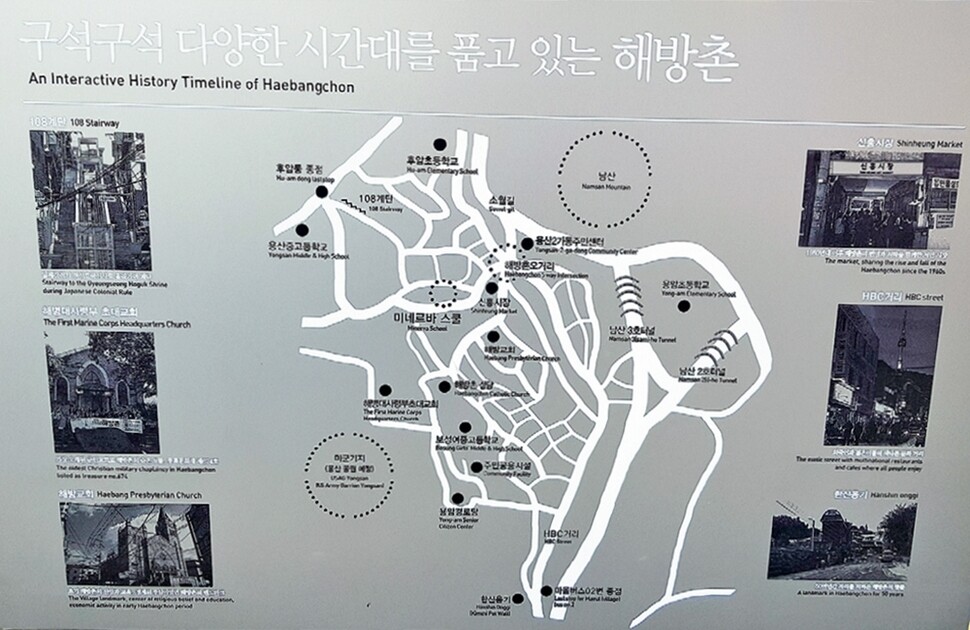
Haebangchon’s maze of alleyways and unique topography make it a favorite area among artists and writers
Now I think I know how Odysseus felt. Like the protagonist of “The Odyssey” returning to his home of Ithaca after 20 years of travels in distant lands, I am finally heading for the streets of my hometown of Seoul.
My young bones were strengthened as I capered about the Seoul alleyways with other neighborhood children, while my “heart muscles” and resilience were confirmed each time I fell down and suffered a scrape or bruise. To borrow a word from human geographer Yi-Fu Tuan, those streets were a place of “topophilia” for me — a special feeling of spatial love for a particular setting.
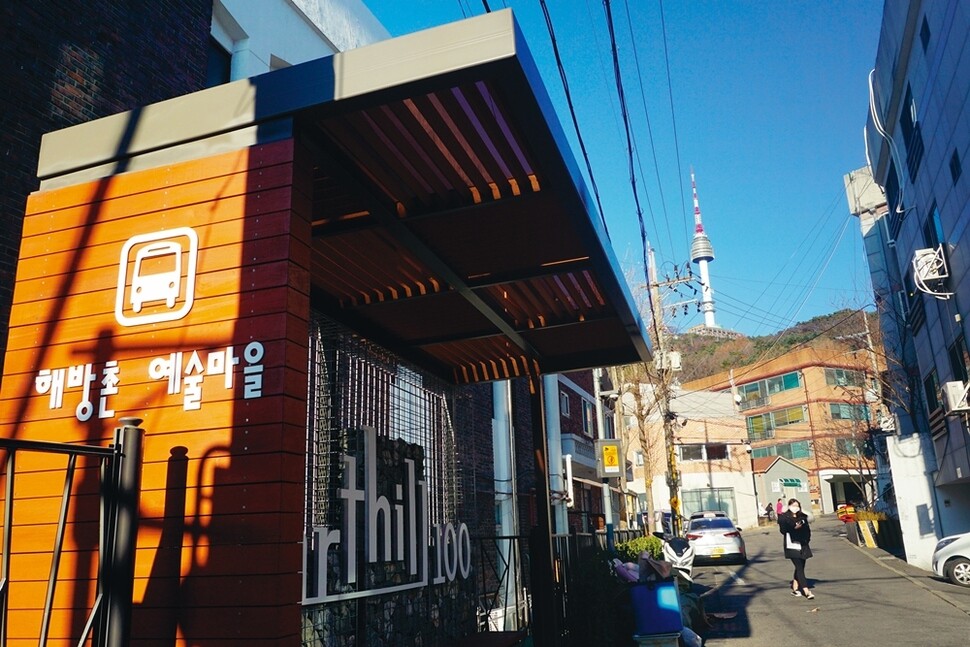
For my destination, I chose the Haebangchon neighborhood in Yongsan. I thought it might offer me the pleasure of climbing to some high locations and breathing deeply as I looked down on the world, and there are also the resonances associated with the word “haebang,” which means “liberation” in Korean. It’s a neighborhood where a unique culture was established around the first village below Mt. Namsan after liberation from Japanese colonial rule. I also have a connection to the place, having given a lecture where I compared Haebangchon with urban renewal in Berlin. What is the community’s context in the eyes of Han Gwang-ya, a Dongguk University professor who has been serving as supervising planner for Haebangchon’s urban renewal since 2015?
“When the snow falls in the winter, it turns into an isolated village. While that can be inconvenient, it’s a preferred neighborhood for artists and writers — people with free professions who want to isolate themselves from the outside,” Han explained.
“It’s also an excellent advantage that it’s good for walking as far as Sowol Road beneath Namsan. If you visit on your own, you can see lots of things and gain peace of mind,” he added.
There are two main ways of walking through Haebangchon: the route down from the Boseong Girls’ High School bus stop midway up the Namsan slope, and up toward Namsan from Noksapyeong Subway Station. I chose the second one; I wanted to experience the neighborhood through its resonance radiating to my feet and heart. Haebangchon is closely associated with the number “two.” Its official legal name as a neighborhood is “Yongsan 2-ga,” and it’s accessed by the subway station’s Exit 2. Two is also the number of the green village bus that travels through its side streets. It’s a means of transportation that affords a vertical journey from the subway station up to the mid-slope five-way Haebangchon Junction, which represents the heart of the neighborhood.
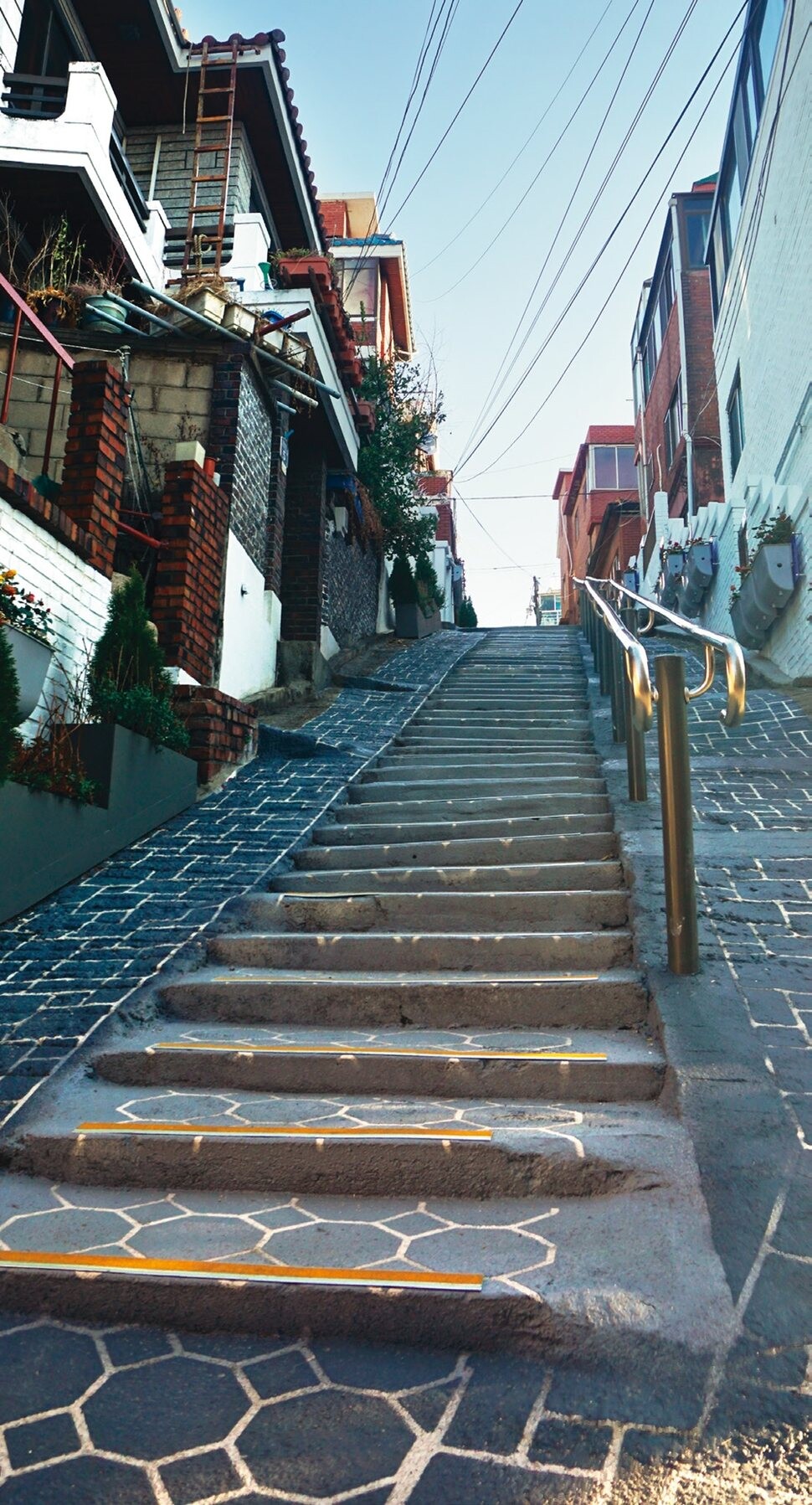
Haebangchon resembles a maze. It’s divided into three parts: the upper neighborhood, the lower neighborhood, and the area around Yongsan High School. The lower neighborhood is close to the subway, with exotic restaurants and cafes; it is known by the Anglicized acronym “HBC” due to its many international residents. The upper neighborhood is where Haebangchon Junction and Sinheung Market are located. That market is a place that holds special meaning, alongside the steeple of Haebang Presbyterian Church, which caters mainly to people hailing from North Pyongan Province in North Korea. For residents, the market has served as both a livelihood and a meeting place — a neighborhood filled with the narratives of profoundly tragic lives.
“A Stray Bullet,” a 1959 novella by Lee Beom-seon, was set against this historical backdrop. It caused a sensation when it was adapted into a film by director Yu Hyun-mok, with a cast including such famous actors as Kim Jin-kyu and Choi Moo-ryong. The story relates to the neighborhood’s onetime history as the site of a firing range, metaphorically representing the struggle for survival and the hopeless future facing protagonist Song Cheol-ho, who has arrived from North Korea to subsist in a cardboard village near the local military base.
Due to its proximity to Myeongdong and Namdaemun Market, the neighborhood experienced growth based on knitting wool crafts. But by the 1990s, it had entered decline, with even Sinheung Market suffering waning fortunes. Amid all of this, it was rejuvenated by urban renewal activists and artists, and it began undergoing a rapid transformation amid interest from small merchants and investors. Sinheung Market is not very large. A café serving “yarn mousse cakes” to symbolize the history of knitting became famous for its addition of a refreshing design touch.
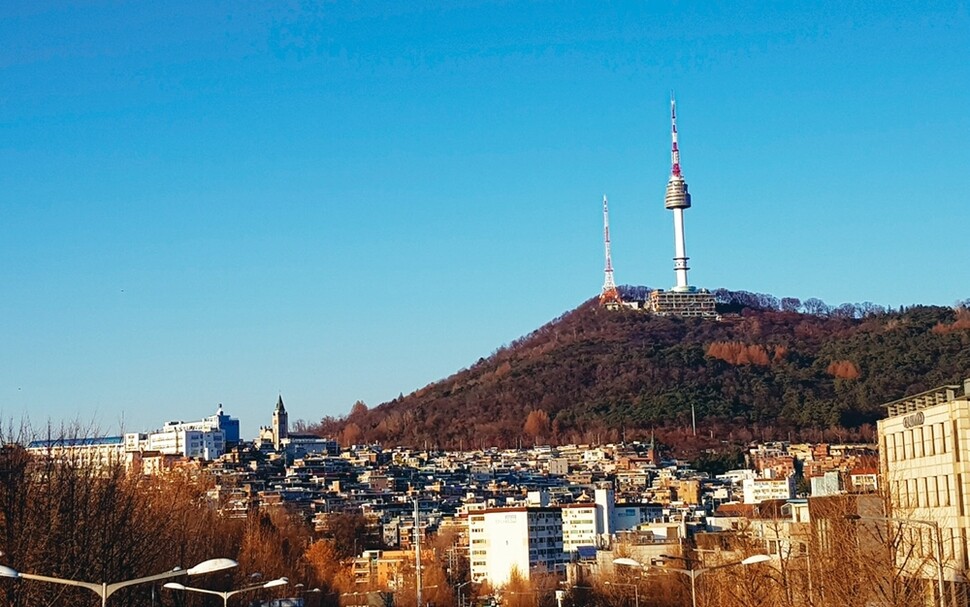
The restaurants and cafés are crucial components of the side street culture. They offer fare ranging from hamburgers to craft beer and even Buddhist temple food for vegans. With the premium afforded by the proximity to Namsan and the opportunity to survey the city from up high, many of the homes have converted their rooftops to recreational spaces. Visiting a Thai restaurant within the market, I could see it had a Thai chef and many international diners — a fitting scene for such a cosmopolitan community.
According to official Yongsan District Office figures, international residents make up just over 11% of Haebanchon’s total population of 12,000 people; unofficially, the number has been estimated at around 15%. It’s a mixture that includes Nigerians who work in cottage industry factories and highly educated English teachers. Traveling up the steep 108 steps toward the intersection brings you to a large, brightly colored building.
Where a shrine once stood during the colonial period and where Soongsil High School was built in the years after Korea’s liberation from Japanese rule, today stands the Minerva School. This is the Seoul campus of a San Francisco-based future-minded university with campuses in eight cities around the world, including London, Berlin, and Buenos Aires.
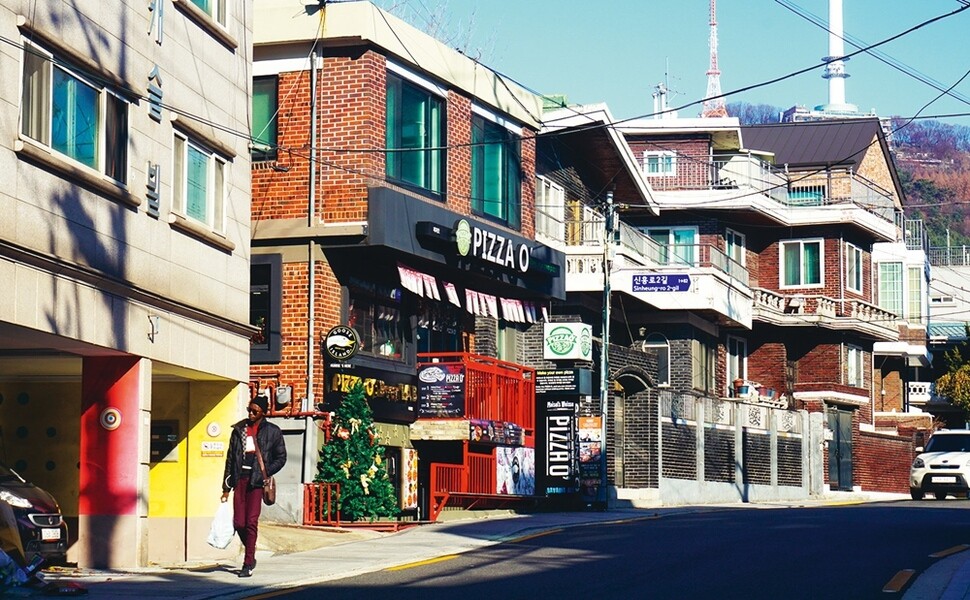
Haebangchon has also felt the impact of gentrification. Rising rent is forcing out the neighborhood’s original inhabitants. Over the past 10 years, many of Seoul’s back alleys have been transformed beyond recognition. They’ve lost their unique “faces” and grown similar to each other, as if they’d all gone as a group to the same plastic surgeon.
Haebangchon is a neighborhood that combines residential areas with productive areas. As such, creating jobs and revitalizing local businesses are the two major objectives of urban regeneration here. Under those circumstances, the challenge is to preserve the neighborhood’s identity.
The steep hills may be romantic, but they’re a challenging place for the elderly and the infirm. I often see older people toiling along, leaning on their canes. Cars roaring down the narrow alleys make the trip to school and back again a nerve-racking experience for children.
A few tiny bookstores and workshops can also be seen on the steep path. What inspiration has this hill given to artists and writers? I read through the first section of the poem “The River” by Hwang In-suk, a life-long resident of Haebangchon:
“I don’t need your sob stories about / How lonely you are, how hard things have been / How you’re going crazy, how you’re holding it together [ . . .]”
This is an age of loneliness, and of being alone. We all complain about feeling lonely. The loneliness only gets worse the higher we go, the gaudier everything becomes. Even while wanting to be on our own, we also hope to make connections with other people. We seem to be awkwardly straddling the boundary between independence and isolation.
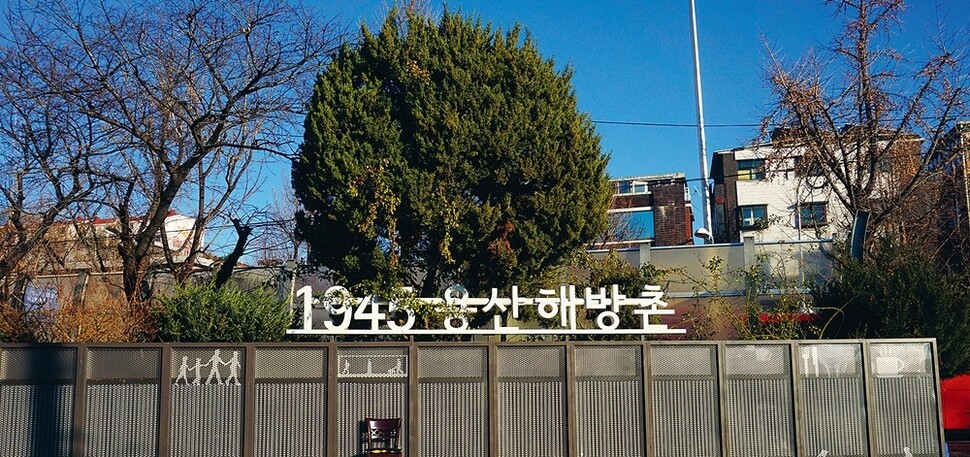
Loneliness creates new cultural phenomena in combination with words such as “me,” “alone,” “alleys,” “walking.” The name Haebangchon carries special connotations for those who don’t want anyone interfering with them, those who seek liberation from the gaze of others.
Walking up the hill, I see a young Western man who looks rather like the painter Amedeo Modigliani emerging from a house. Modigliani’s good looks and smart style were apparently enough to convince quite a few women to take up his offer to model for a portrait at his studio in Montmartre.
In fact, Haebangchon has a number of similarities with Montmartre, the famous hill in Paris. Those similarities include its steep slopes and stairs and its popularity with foreigners and people down on their luck. Montmartre was where Dutch painter Vincent Van Gogh and Spanish painter Pablo Picasso had their first studios — back when they were poor, before they became famous.
It’s true: a traveler is one who dreams. I’m talking about the dream that what is currently on the fringe will one day become the center of the world. Just like Montmartre, Haebangchon is another hill of dreams. Climbing up Sowol-ro, the road that loops around Namsan, that idea came home to me.
The public parking lot there functions as a natural rooftop with a gorgeous view, marking the terminus of my journey. Haebangchon is the kind of place where you can spend three pleasant hours for about 10,000 won. Perhaps you’ll have the good fortune of stumbling upon the answer to life’s riddle as you wander through its labyrinth of alleyways.’’
By Son Kwan-seung, travel writer
Edited by the editorial board at Seoul&
Please direct comments or questions to [english@hani.co.kr]
Editorial・opinion
![[Column] Welcome to the president’s pity party [Column] Welcome to the president’s pity party](https://flexible.img.hani.co.kr/flexible/normal/500/300/imgdb/original/2024/0515/3917157400447943.jpg) [Column] Welcome to the president’s pity party
[Column] Welcome to the president’s pity party![[Editorial] Korea must respond firmly to Japan’s attempt to usurp Line [Editorial] Korea must respond firmly to Japan’s attempt to usurp Line](https://flexible.img.hani.co.kr/flexible/normal/500/300/imgdb/original/2024/0514/2317156736305813.jpg) [Editorial] Korea must respond firmly to Japan’s attempt to usurp Line
[Editorial] Korea must respond firmly to Japan’s attempt to usurp Line- [Editorial] Transfers of prosecutors investigating Korea’s first lady send chilling message
- [Column] Will Seoul’s ties with Moscow really recover on their own?
- [Column] Samsung’s ‘lost decade’ and Lee Jae-yong’s mismatched chopsticks
- [Correspondent’s column] The real reason the US is worried about Chinese ‘overcapacity’
- [Editorial] Yoon’s gesture at communication only highlights his reluctance to change
- [Editorial] Perilous stakes of Trump’s rhetoric around US troop pullout from Korea
- [Guest essay] Preventing Korean Peninsula from becoming front line of new cold war
- [Column] The state is back — but is it in business?
Most viewed articles
- 1[Column] Welcome to the president’s pity party
- 2Could Korea’s Naver lose control of Line to Japan?
- 3[Editorial] Transfers of prosecutors investigating Korea’s first lady send chilling message
- 4[Editorial] Korea must respond firmly to Japan’s attempt to usurp Line
- 5Naver’s union calls for action from government over possible Japanese buyout of Line
- 6Major personnel shuffle reassigns prosecutors leading investigations into Korea’s first lady
- 7US has always pulled troops from Korea unilaterally — is Yoon prepared for it to happen again?
- 8[Column] Will Seoul’s ties with Moscow really recover on their own?
- 9[Correspondent’s column] The real reason the US is worried about Chinese ‘overcapacity’
- 10[Column] Samsung’s ‘lost decade’ and Lee Jae-yong’s mismatched chopsticks